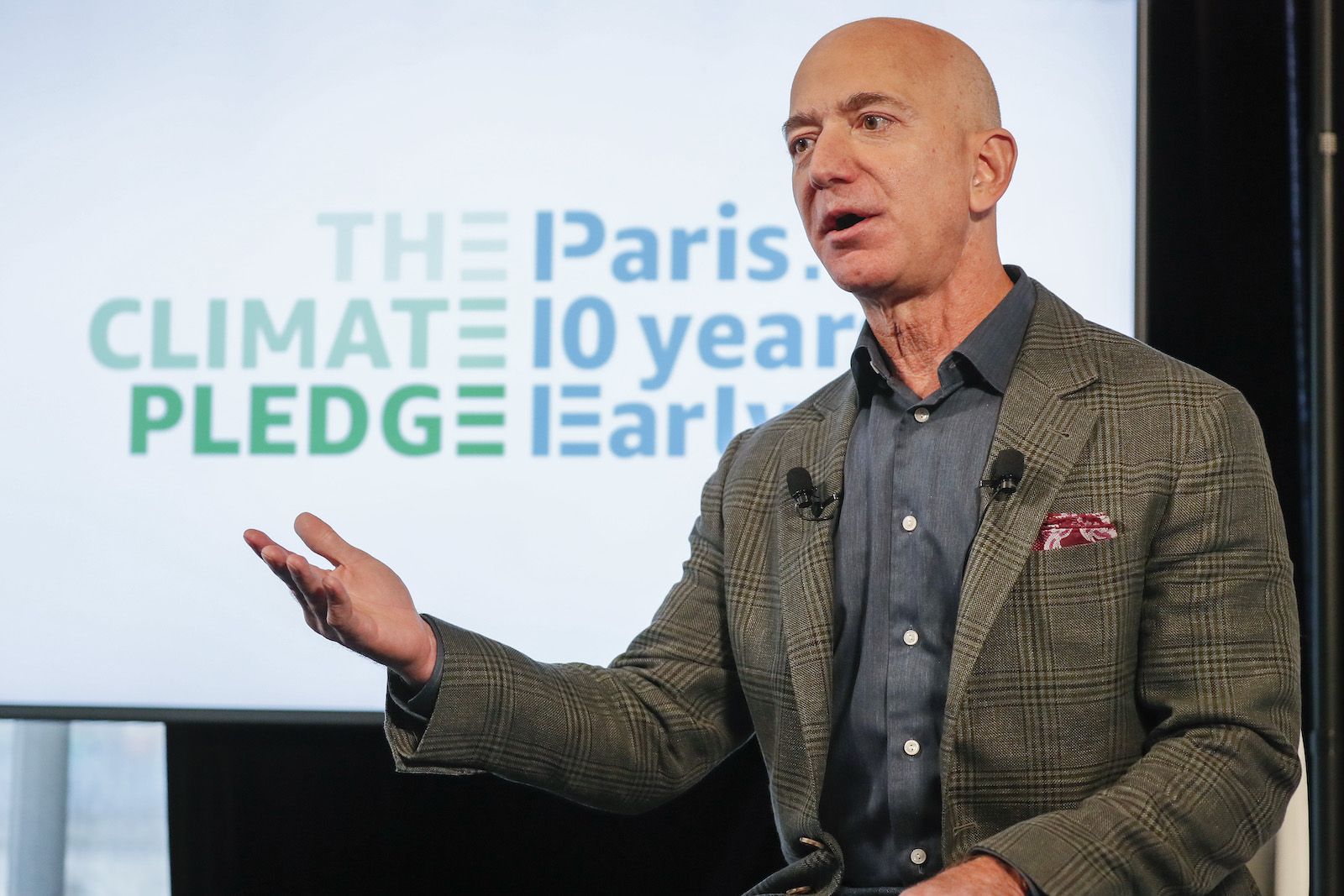This story was originally published by Reveal and is reproduced here as part of the Climate Desk collaboration.
This is how Amazon washes its hands of the climate impact of most of the things it sells: It simply decides to play by different rules than its peers.
For example, for all the packs of Pampers parents grab off the shelf at Target, the big-box retailer tallies the emissions that go into making those diapers as part of its carbon footprint. And when customers order Samsung TVs on Target.com, the company tacks on not only the carbon that went into making them, but also the emissions that will end up in the atmosphere when people plug in and use them.
But when shoppers click “Buy Now” on those same products on Amazon, the nation’s largest online retailer doesn’t count those carbon emissions. Amazon takes responsibility for the full climate impact only of products with an Amazon brand label, which make up about 1 percent of its online sales.
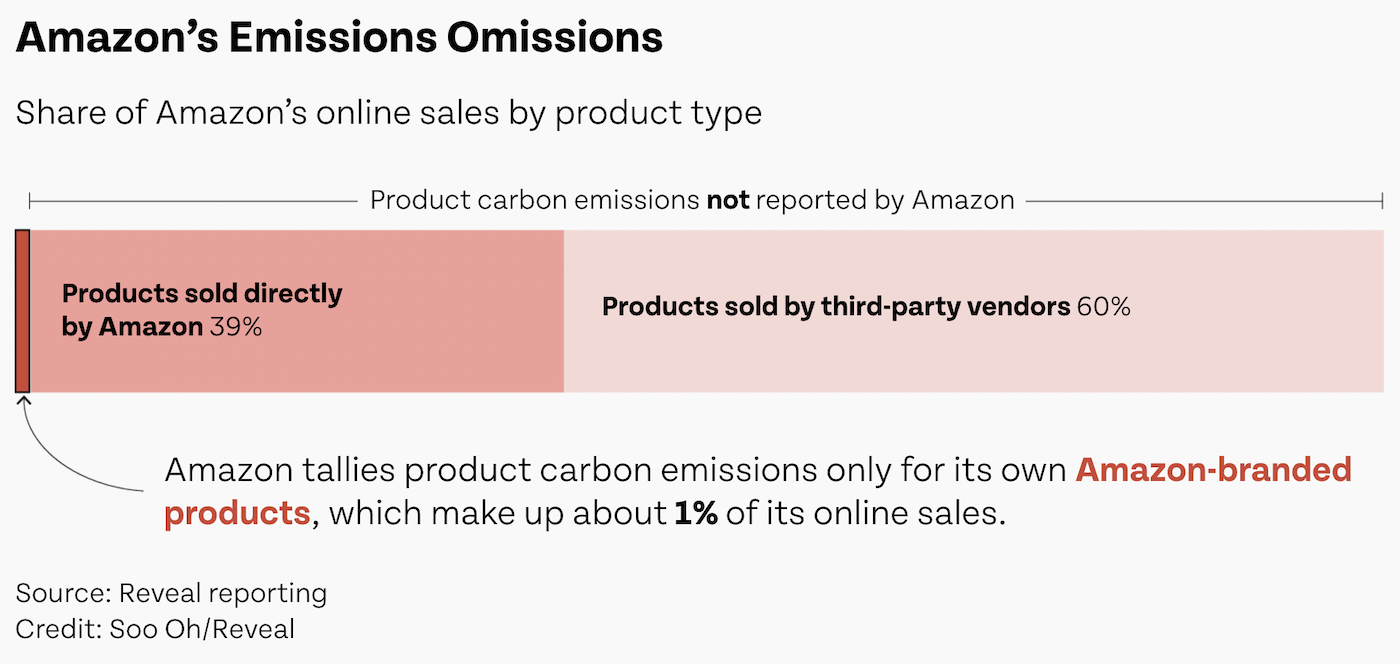
And so the company, named after a river twisting through a rainforest already damaged by climate change, vastly undercounts its carbon footprint, accepting less responsibility for global warming than even smaller competitors.
Over the past two decades, under pressure from investors and activists, thousands of companies have agreed to disclose their carbon footprints to a nonprofit organization named CDP (originally known as the Carbon Disclosure Project).
Reveal from The Center for Investigative Reporting obtained Amazon’s report, and the detailed accounting within illuminates how such a massive company manages to boast such a small carbon footprint.
The report also highlights the pitfalls of relying on self-disclosures and voluntary commitments from companies that have a vested interest in underestimating their own accountability. Amazon has positioned itself as a climate change leader, promoting a “Climate Pledge” to zero out emissions by 2040. But by not counting all of its emissions, it isn’t on the hook for cutting them.
Let’s break down the ways that Amazon manages to downplay its carbon footprint.
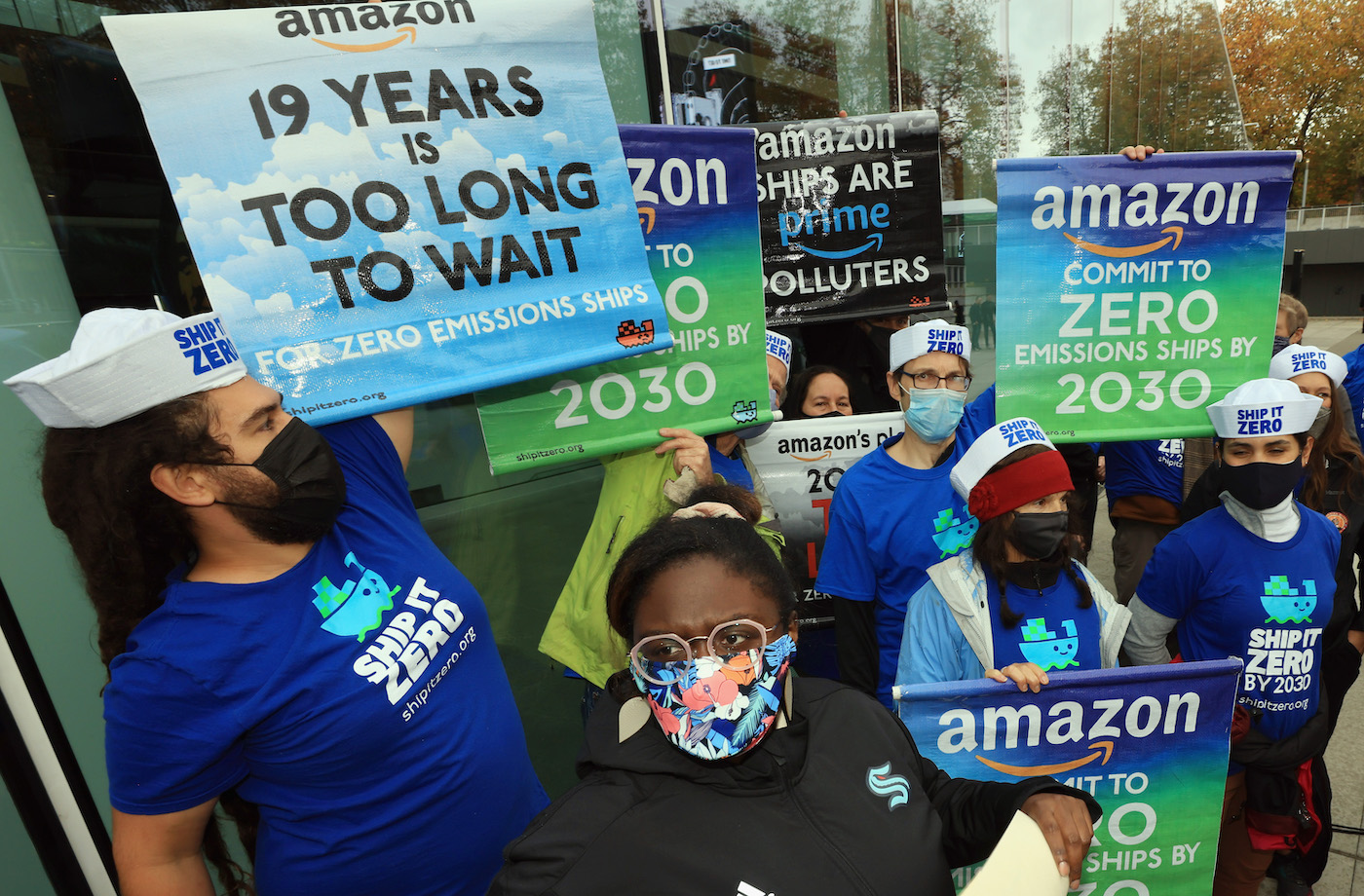
Amazon’s Biggest Climate Gap
Usually, the biggest chunk of a retailer’s carbon footprint comes from all the products it sells. And that’s where Amazon has the biggest gaps.
Just take all the greenhouse gases spewed into the atmosphere from manufacturing the things a retailer sells. For everything with a plug, add in the electricity they eat up when they’re on. Then tack on the emissions from eventually throwing them away.
For that lifecycle of consumer products, Target’s report, which it makes public, showed triple the amount of carbon emissions that Amazon’s did. That represents 37.5 million metric tons of carbon dioxide more than Amazon, the equivalent of just over 8 million cars driven for a year.
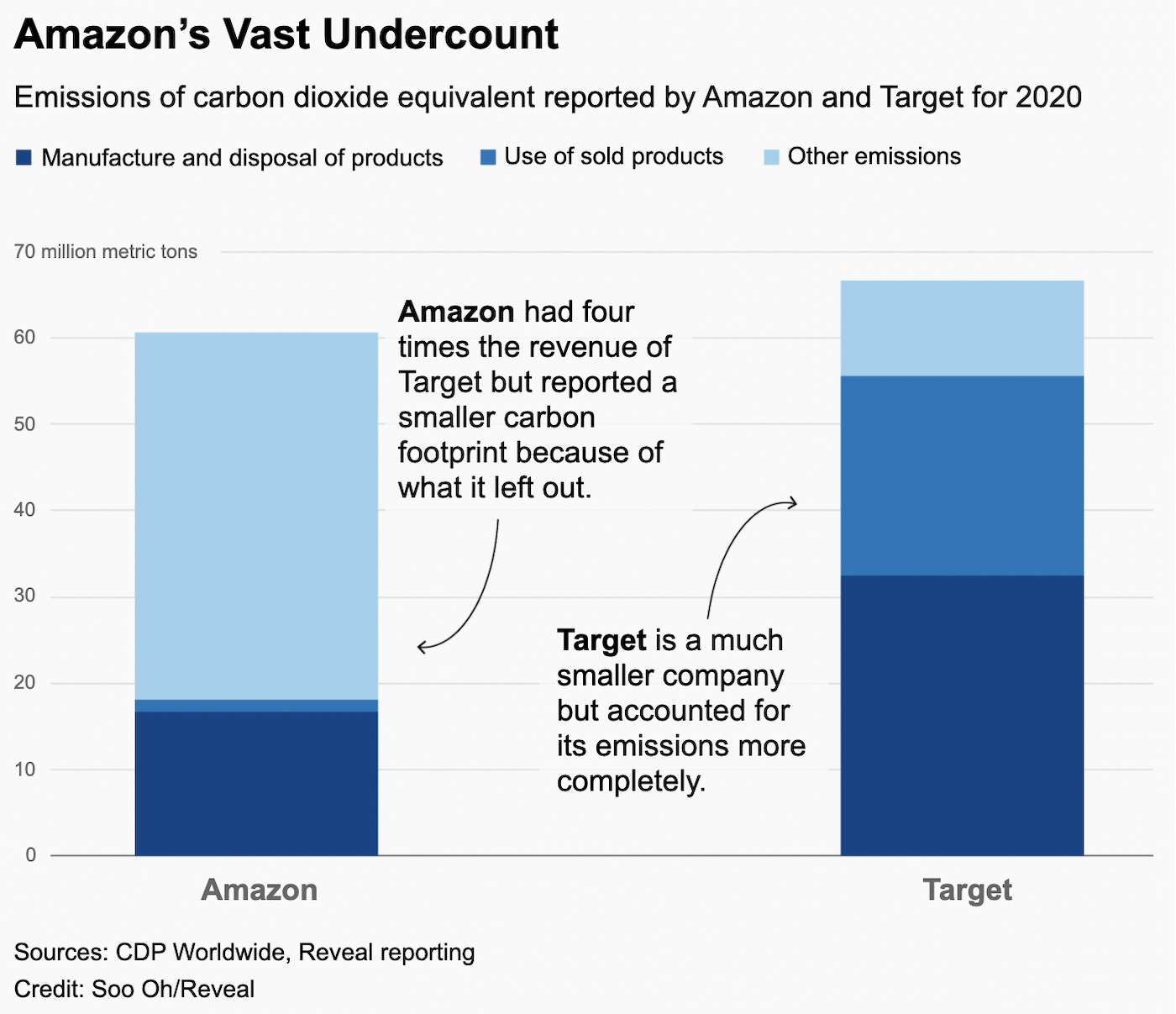
And that’s for a year Amazon racked up well over $100 billion more in sales than Target. How is that possible? Well, Amazon counts only products labeled with its private brands – the Echo Dots, Kindles, and AmazonBasics staples, for example. Those, the company has told Congress, total 1 percent of its online sales.
There’s another 39 percent of sales that Amazon should be counting if it were using the same accounting as its peers. These are the products that Amazon buys from manufacturers and sells directly to the customer. They’re made by other companies – think Levi’s, Nintendo, Frigidaire – but their product listings say “ships from” and “sold by” Amazon.com. Target and Walmart stock these same brands. But unlike Target and Walmart, Amazon doesn’t count the emissions that go into making these products – or those that come out of them.
So these products might even be labeled “Climate Pledge Friendly” on Amazon – like a box of Kleenex tissues. But the company doesn’t actually count them toward its Climate Pledge.
(The remaining 60 percent of Amazon’s sales come from third-party vendors who use Amazon as an online marketplace; Amazon doesn’t count those emissions either, but that’s more of a gray area. Amazon spokesperson Luis Davila said third-party sellers “control their own carbon emissions accounting.” Walmart, which also has third-party sellers hawking wares on its website, says it does count those products in its carbon footprint. Target wouldn’t comment on whether it counts third-party sales.)

CDP uses what’s known as the Greenhouse Gas Protocol, which lays out how companies should be measuring emissions. Amazon says it follows that protocol and has committed to getting its goals validated by the Science Based Targets Initiative, a partnership of CDP and other groups that certifies corporate plans to reduce emissions and requires using the protocol.
But the protocol doesn’t allow companies to count only their own private brand products. Under the protocol, retail companies should be counting all the products they sell directly to consumers, said Alberto Carrillo Pineda, managing director of the Science Based Targets Initiative.
“Everything you purchased should be included, and everything that you sell should be included,” he said.
(Carrillo Pineda said his organization will have to get a third party to evaluate Amazon because it received $18 million from Amazon’s founder through the Bezos Earth Fund.)
It’s true that these indirect emissions from a company’s supply chain, called Scope 3 emissions, are notoriously difficult to tally, and many companies use guesstimates. But they often represent the majority of a company’s impact on the environment, and counting them forces companies to put pressure on suppliers to clean up their act, too.
There’s another thing Amazon isn’t counting that its peers do. It’s not a large part of Amazon’s footprint – maybe more of a toenail – but it sets the company apart from its rivals.
With triple the number of employees of Target in 2020, Amazon counted 29 percent fewer emissions from their commutes.
That’s because while Target, Walmart, and The Home Depot estimate the gas their workers burn while driving to and from work, Amazon counts emissions only from its own corporate shuttles. Asked about the discrepancy, Amazon’s Davila said: “Employees can use public transportation to get to the office, and if they live nearby, they can walk or bike.”
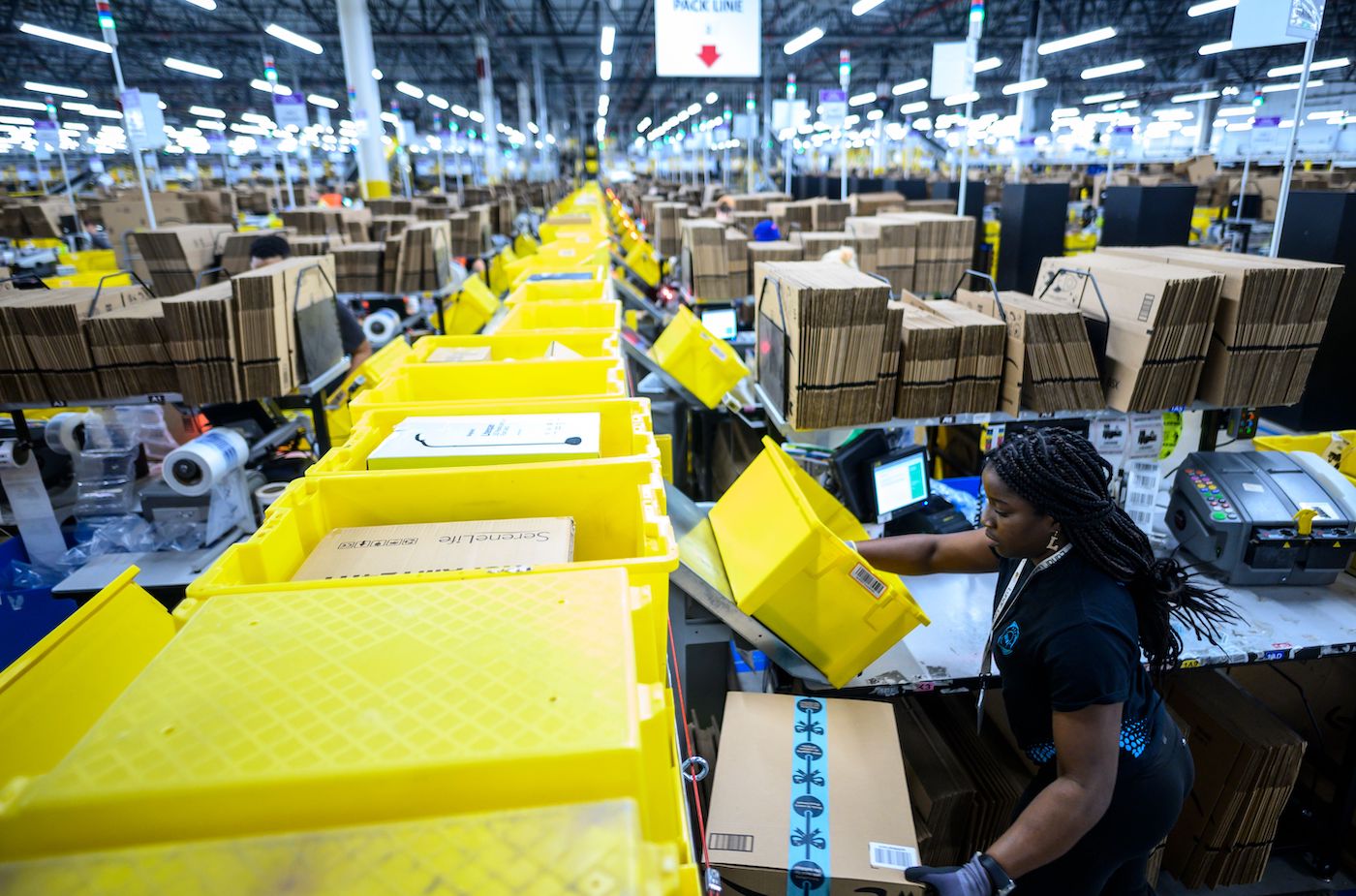
What It All Adds Up To
So with quadruple the revenue of Target in 2020 and a sprawling global empire that Target doesn’t have, Amazon actually reported fewer overall emissions than Target that year: the equivalent of about 61 million metric tons of carbon dioxide for Amazon vs. 67 million metric tons for Target.
And that can have real-world consequences.
Both Amazon and Target have committed to going “net zero” by 2040, slashing carbon emissions and compensating for what’s left with carbon offsets. So because of what Amazon fails to count, it’s on the hook for eventually canceling out fewer emissions than Target, despite its far bigger impact on global temperatures.
If Amazon were counting its footprint like some of its competition, it would have to get rid of tens of millions more tons of carbon emissions – by radically transforming its business, forcing suppliers to change their own operations, paying for enormous amounts of controversial carbon offsets or maybe even confronting whether The Climate Pledge is compatible with Amazon’s business model after all.
Davila didn’t directly address why the company doesn’t account for the climate impact of most of the products it sells, but reiterated its commitment to cutting emissions, including ordering a fleet of electric delivery vans and buying renewable energy for its electricity needs.
“Amazon is also finding, investing in, and building new solutions to meet the urgency of the climate crisis,” Davila said in a statement.
Amazon Trumpets Itself as a Climate Leader
But Amazon has heralded itself as a leader of the pack on climate change, a company others must follow to save the planet. “We want to use our scale and our scope to lead the way,” founder Jeff Bezos said in announcing The Climate Pledge in 2019, positioning his company as “a role model for this.” The pledge now has more than 200 signatories, and Amazon boasts a $2 billion Climate Pledge Fund and a Seattle sports stadium named the Climate Pledge Arena.
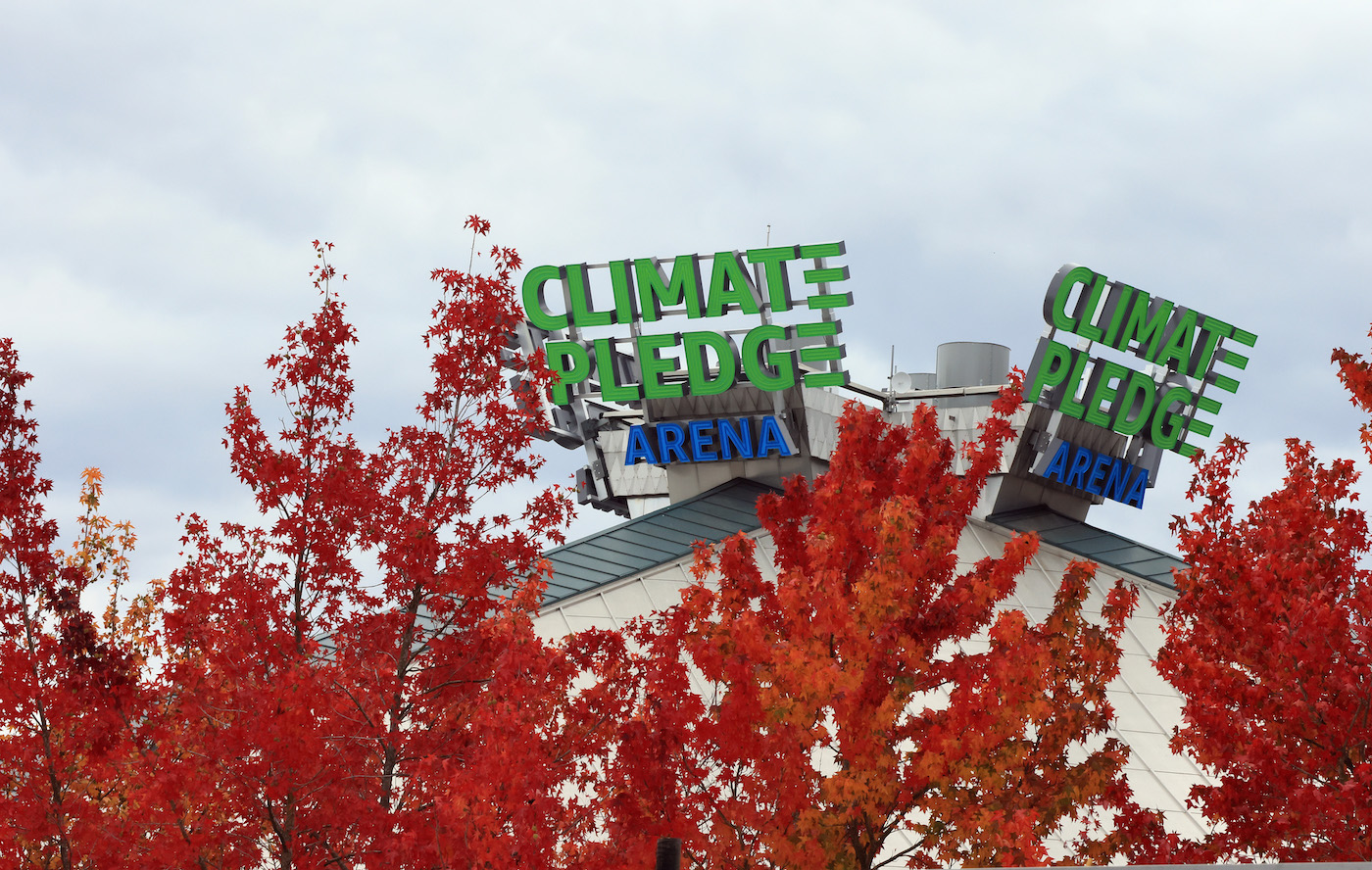
There’s a backstory to the company’s climate marketing. It’s faced intense pressure from a group of inside agitators, Amazon Employees for Climate Justice. Bezos’ announcement came on the eve of an employee walkout protesting the company’s lack of action. Less than a year later, two of the group’s organizers were fired in what the National Labor Relations Board determined was illegal retaliation, leading to a settlement last year.
A group spokesperson, Eliza Pan, is actually a former employee. She speaks for the group because current employees are worried Amazon would exact vengeance if they spoke out.
“It seems like Amazon is misleading employees and the public,” she said, “or even being straight-up deceptive about how well it’s doing against its climate goals.”
Amazon’s Headed in the Wrong Direction Anyway
Even with the holes in Amazon’s accounting, the company that promises to get to zero by 2040 is going in the wrong direction. Its reported carbon footprint increased just over 36 percent from 2018 to 2020.
Faced with that inconvenient data point, Amazon argues publicly that its “carbon intensity” – the amount of carbon it emits per dollar it makes – improved 16 percent in 2020.
“This year-over-year carbon intensity comparison reflects our early progress to decarbonize our operations as we also continue to grow as a company,” Amazon’s public sustainability report states.
But privately, Amazon’s CDP report shows a less impressive figure. CDP asks companies to measure carbon intensity based on their most direct impact and the hardest area to fudge: emissions from their own energy consumption and operations.
Looked at that way, Amazon’s improvement was 3.9 percent in 2020 and didn’t stack up well against competitors. Amazon calculated a rate of about 39 metric tons of carbon emissions per $1 million of revenue, compared with 29 for Walmart and 20 for Target. Asked about the comparison, Davila said, “We can’t speak for other companies.”
To avoid increasingly catastrophic ravages of climate disaster, scientists warn that the Earth needs to reach “net zero” by midcentury. Humans are not on track, and many environmentalists worry that corporate promises to save the world risk lulling the public into dangerous complacency.
Amazon, though, stays positive. “We are relentlessly optimistic about the future,” Kara Hurst, Amazon’s vice president of worldwide sustainability, wrote in last year’s public sustainability report.
But the end of the report includes a boilerplate disclaimer: “No assurance can be given that any plan, initiative, projection, goal, commitment, expectation, or prospect set forth in this report can or will be achieved.”
In other words, don’t hold us to it.
This story was edited by Andrew Donohue and copy edited by Nikki Frick.

